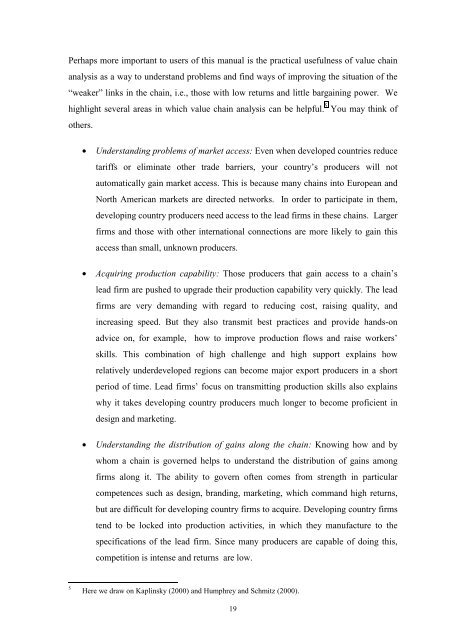McCormick+Schmitz Handbook for value chain research on - PACA
McCormick+Schmitz Handbook for value chain research on - PACA
McCormick+Schmitz Handbook for value chain research on - PACA
Create successful ePaper yourself
Turn your PDF publications into a flip-book with our unique Google optimized e-Paper software.
Perhaps more important to users of this manual is the practical usefulness of <str<strong>on</strong>g>value</str<strong>on</strong>g> <str<strong>on</strong>g>chain</str<strong>on</strong>g><br />
analysis as a way to understand problems and find ways of improving the situati<strong>on</strong> of the<br />
“weaker” links in the <str<strong>on</strong>g>chain</str<strong>on</strong>g>, i.e., those with low returns and little bargaining power. We<br />
highlight several areas in which <str<strong>on</strong>g>value</str<strong>on</strong>g> <str<strong>on</strong>g>chain</str<strong>on</strong>g> analysis can be helpful. 5 You may think of<br />
others.<br />
• Understanding problems of market access: Even when developed countries reduce<br />
tariffs or eliminate other trade barriers, your country’s producers will not<br />
automatically gain market access. This is because many <str<strong>on</strong>g>chain</str<strong>on</strong>g>s into European and<br />
North American markets are directed networks. In order to participate in them,<br />
developing country producers need access to the lead firms in these <str<strong>on</strong>g>chain</str<strong>on</strong>g>s. Larger<br />
firms and those with other internati<strong>on</strong>al c<strong>on</strong>necti<strong>on</strong>s are more likely to gain this<br />
access than small, unknown producers.<br />
• Acquiring producti<strong>on</strong> capability: Those producers that gain access to a <str<strong>on</strong>g>chain</str<strong>on</strong>g>’s<br />
lead firm are pushed to upgrade their producti<strong>on</strong> capability very quickly. The lead<br />
firms are very demanding with regard to reducing cost, raising quality, and<br />
increasing speed. But they also transmit best practices and provide hands-<strong>on</strong><br />
advice <strong>on</strong>, <str<strong>on</strong>g>for</str<strong>on</strong>g> example, how to improve producti<strong>on</strong> flows and raise workers’<br />
skills. This combinati<strong>on</strong> of high challenge and high support explains how<br />
relatively underdeveloped regi<strong>on</strong>s can become major export producers in a short<br />
period of time. Lead firms’ focus <strong>on</strong> transmitting producti<strong>on</strong> skills also explains<br />
why it takes developing country producers much l<strong>on</strong>ger to become proficient in<br />
design and marketing.<br />
• Understanding the distributi<strong>on</strong> of gains al<strong>on</strong>g the <str<strong>on</strong>g>chain</str<strong>on</strong>g>: Knowing how and by<br />
whom a <str<strong>on</strong>g>chain</str<strong>on</strong>g> is governed helps to understand the distributi<strong>on</strong> of gains am<strong>on</strong>g<br />
firms al<strong>on</strong>g it. The ability to govern often comes from strength in particular<br />
competences such as design, branding, marketing, which command high returns,<br />
but are difficult <str<strong>on</strong>g>for</str<strong>on</strong>g> developing country firms to acquire. Developing country firms<br />
tend to be locked into producti<strong>on</strong> activities, in which they manufacture to the<br />
specificati<strong>on</strong>s of the lead firm. Since many producers are capable of doing this,<br />
competiti<strong>on</strong> is intense and returns are low.<br />
5<br />
Here we draw <strong>on</strong> Kaplinsky (2000) and Humphrey and Schmitz (2000).<br />
19














